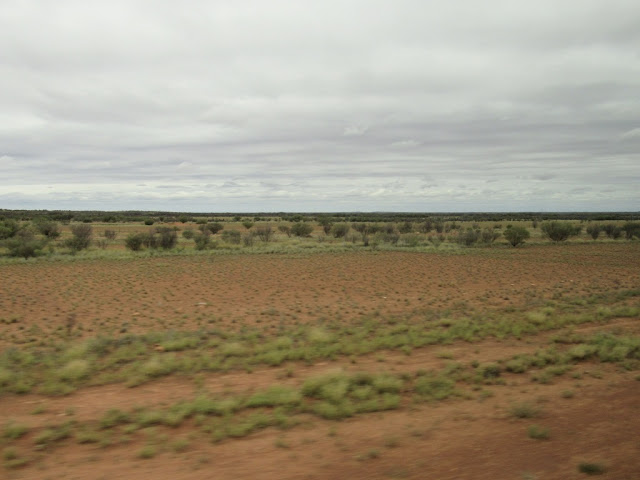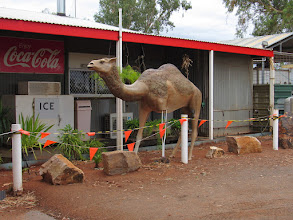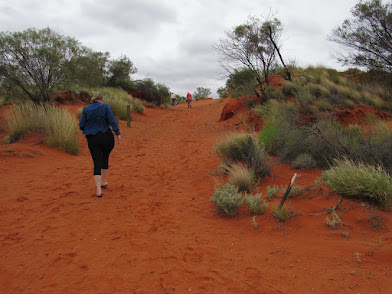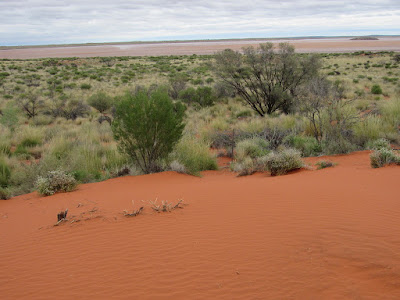Desolation.
Emptiness. Extreme heat. Endlessly straight roads with little to look at,
few passing cars, and dangerous shoulders if you veer off the two-lane
highway. Occasional stops with kooky attractions. Red soil. This is the Outback.
We spent a long day traveling by bus in the Outback from Alice Springs to Yulara where we saw Uluru, the Aborigines' sacred monument of red rock. We stopped at some rest stops plunked in the middle of nowhere, which provided necessary rooms, a restaurant, a store stocked with junk food, and different sorts of wacky Aussie entertainment and wit.
Although the roads are largely free of potholes and cracks, they are rugged, which makes riding them a little bumpy. Roll-overs in the Outback are common, and it's easy to see why. There is not much road on the edges of these two-lane highways, and shoulders are sandy. The monotony of straight roads can cause distraction and sleepiness. Drivers must plan for journeys in the Outback that may last 8-10 hours with enough food, water, fuel, and attentive energy.

Twenty years ago there were 200 deaths a year in the Outback due to road accidents. The government installed warning signs to assist people with strategies for driving through these regions. Today, deaths amount to 20 per year. For example, one cautionary practice for drivers with accidents or breakdowns is to stay in the vehicle so that rescuers can more easily find the person(s). Besides, the heat of the Outback can cause dehydration if a person were to walk on the road. Although there are satellite cell phone available, coverage is limited. The Flying Doctors are available 24/7/365 to help. (Click here for information about this service and scroll to the end of the blog.)
I asked our bus driver what would happen if our bus broke down. He said he is in constant touch with his company so he would call them and they would send a bus out right away. We would not be stranded in the Outback.
Mark, our expert bus driver made us feel perfectly safe with him at the wheel of our big, white bus. He also looked like the stereotypical Aussie that we were always looking for.
Erldunda -- Rest stop with emu entertainment




We had a nice lunch here and enjoyed the amenities around the station. This place had previously been a cattle station. A station is a farm. Most of these farms are huge, like an area of thousands of square miles in size.


Restrooms included toilets and showers.

A couple relics of the past that still operate today.
Stuart's Well -- rest stop

The owner of this rest stop apparently had a love for camels. Actually, in the history of the Outback, camels were the only animals able to make it in the desert climate. They were brought to Australian by "the Afghans", men the British colonialists brought here to build the roads in the Outback from the 1860s to the 1930s. They were referred to as "Afghans" even though they originated from the western parts of India, Iran, and Pakistan (also British colonies). They set up camel-breeding stations and rest-house outposts in order to create links between the coastal cities and the remote cattle and sheep grazing stations.

Half a million visitors come to the Outback each year and Stuart's Well (a.k.a. Jim's Place) has become an important tourism hub providing services, supplies, and information to visitors intent on exploring the natural wonders of the region. The Jim Cotterill family, who immigrated to Australia from England, have played an integral role in developing tourism here.
Outback Look-out Point
As we came closer to Uluru, we stopped for a look on a red-red dune and discovered an ancient salt lake that used to be the floor of an ocean hundreds of millions of years ago. It's the biggest lake in Australia, but it has no water except every 7-8 years or so. The early settlers were unable to traverse it because their animals and wagon wheels got stuck in it. So they steered around it--no small feat because the lake goes on for miles and miles.
In the Outback, most of what you see is flat land and sky with bushes of different greens. The salt lake is in the distance.
Mt. O'Connor is part of Uluru, which is actually a range of mountain tops related to one another. Several members of our group who flew in a helicopter over Uluru noticed that this range of mountains is all in a straight line. Mt. O'Connor is the biggest.
Resources
https://en.wikipedia.org/wiki/Afghan_cameleers_in_Australia


























No comments:
Post a Comment